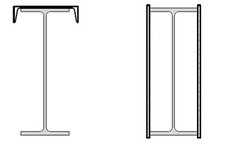SALTRAM4567777
Structural
I have a propped cantilever beam. The total length of the beam is 15m with a 4m overhang. At the two supports its is bearing on the concrete columns with bottom flange bolts. The beam is totally unrestrained. To my question, AISC provides no K factor for LTB. Since at the suports my top flange is laterally not supported. Should I only use Cb=1. How AISC takes care for the K factor like in BS Codes. Excuse my drawing

